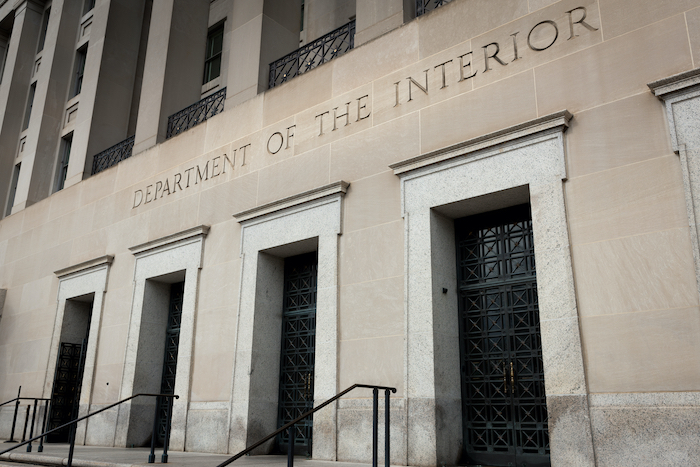
- Details
- By Jenna Kunze
WASHINGTON — The Department of the Interior this week asked tribal governments, Alaska Native Corporations, and Native Hawaiian groups to weigh in on its Federal Indian Boarding School Initiative, announced in June by Secretary Deb Haaland in an effort to shed light on the dark history of the Indian Boarding School System.
For more than a century beginning in the late 1800s, the United States forcibly removed thousands of Native youth from their homes and sent them to far-away boarding schools to be “re-educated” into white society. At the schools, many suffered illness, abuse and neglect, often resulting in death.
Want more Native News? Get the free daily newsletter today.
It’s unknown exactly how many Indian Boarding schools the US operated, how many children went through them, and how many died while at school.
Haaland’s initiative—prompted by the discovery of an unmarked grave containing 215 children at the Kamloops Indian Residential School in British Columbia, Canada—is aimed at answering those questions. Tribal consultation marks “a new phase” in the ongoing work of this initiative, beginning with compiling decades of records to identify missing information, according to the agency’s press release.
“Tribal consultations are at the core of this long and painful process to address the intergenerational trauma of Indian boarding schools and to shed light on the truth in a way that honors those we have lost and those that continue to suffer trauma,” Secretary Haaland said in a statement Thursday.
Tribes are invited to testify in one of three scheduled webinar consultation sessions in November to weigh in on topics such as: protocol for handling sensitive information; how to address cultural concerns in handling records; repatriating human remains; protecting burial sites; privacy issues; and management of former boarding schools.
Since the initiative was announced in June, tribal leaders have expressed relief at the federal government’s long-awaited actions to try to right some of their wrongs.
At the Rosebud Sioux tribe in South Dakota, a Nation who just this summer brought home nine of their relatives who were buried at the Carlisle Indian Industrial School for more than a century, tribal historic preservation officer Ione Quigley told Native News Online she has some advice to share with the DOI.
“It’s that every tribe has their own way, their own process of doing things: culturally, spiritually,” she said. “The advice I have to give is that you respect each other's beliefs, and each other's cultural differences.”
Help us tell Native stories that get overlooked by other media.
Quigley added that, in her own tribe’s experience, it was difficult to obtain documentation from the Bureau of Indian Affairs. Instead, the tribe relied on the local historical society and college archive center to get the records they needed.
“If we had access to these records it would have been faster and smoother for us,” she said. “There's got to be a better process so that we can have better access to records.”
Tribes interested in providing testimony can sign up for a webinar consultation here. They will be held from 1 p.m. to 5 p.m. Eastern Time on Nov. 1, 16, and 18.
Written comments can be submitted to the DOI via email at [email protected] and must be sent by Dec. 1. Tribal consultations will be closed to the press and the public to protect confidential information that may be discussed during the sessions, DOI spokesperson Tyler Cherry said.
A final report on the DOI’s investigation will be due to Haaland on April 1, 2022.
“If people are willing to work hard, it can be done. It has to be,” Quigley said of the short time frame. “Because we don't know what's in store for within the next couple of years….so we’ve got to take advantage of this time and of the leadership right now.”
More Stories Like This
50 Years of Self-Determination: How a Landmark Act Empowered Tribal Sovereignty and Transformed Federal-Tribal RelationsNavajo Nation Council Members Attend 2025 Diné Action Plan Winter Gathering
Ute Tribe Files Federal Lawsuit Challenging Colorado Parks legislation
NCAI Resolution Condemns “Alligator Alcatraz”
NABS Documents 134 More Survivor Stories, Expands Digital Archive in 2025
Help us defend tribal sovereignty.
At Native News Online, our mission is rooted in telling the stories that strengthen sovereignty and uplift Indigenous voices — not just at year’s end, but every single day.
Because of your generosity last year, we were able to keep our reporters on the ground in tribal communities, at national gatherings and in the halls of Congress — covering the issues that matter most to Indian Country: sovereignty, culture, education, health and economic opportunity.
That support sustained us through a tough year in 2025. Now, as we look to the year ahead, we need your help right now to ensure warrior journalism remains strong — reporting that defends tribal sovereignty, amplifies Native truth, and holds power accountable.
 The stakes couldn't be higher. Your support keeps Native voices heard, Native stories told and Native sovereignty defended.
The stakes couldn't be higher. Your support keeps Native voices heard, Native stories told and Native sovereignty defended.
Stand with Warrior Journalism today.
Levi Rickert (Potawatomi), Editor & Publisher

